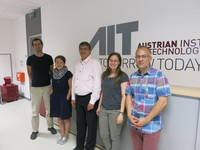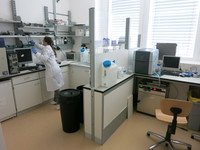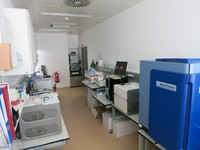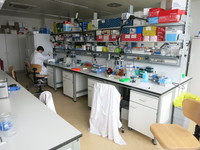Austrian Institute of Technology
Austrian Institute of Technology
Institution :
AIT Austrian Institute of Technology GmbH takes a leading position in the Austrian innovation system and a key role in Europe as the research and technology organization focusing on the key infrastructure topics of the future. AIT provides research and technological development to realize basic innovations for the next generation technologies in the fields of health & environment, energy, mobility and safety & security. Our technological research areas are further supplemented by in-depth knowledge and competence for innovation systems.
The MOLECULAR DIAGNOSTICS business unit within the Health & Environment Department established a number of Omics-technology platforms in-house to develop biomarker panels for early diagnosis, patient stratification and monitoring progression of life threatening diseases. We assist clinical and industrial organizations in executing programs and act as trusted partner while adding value to the research portfolio in unique ways. Our scientific expertise and know-how is focused on disease relevant biomarker programs including infectious diseases, autoimmunity, oncology, chronic disorders and other areas of high medical need. With the growing demand for non-invasive and rapid diagnostic testing solution, not least driven by the demographic development, personalized medicine concepts tailored for specific applications are steadily developed. In this context, saliva has recently emerged as an interesting diagnostic fluid of choice and there are already a number of saliva-based tests present on the market (e.g. HIV, alcohol, drugs of abuse, hormones). Our long-term vision at AIT is to become a key-player for saliva and minimal–invasive diagnostic assays (e.g. blood, tissue) suitable to detect life threating human diseases at an early stage and to monitor the therapeutic effect of novel drugs.
In FAPIC, a well balanced team of experienced researchers (Ulrich Giese, Ivan Barisic), lab technicians (Silvia Schönthaler, Ronald Kulovics), two PhD (Michaela Hendling) and six Diploma students (Lukas Tegel) will be responsible for the development of the novel DNA assay and the software tools.
Role in the project:
The main task of the AIT in FAPIC is to develop a DNA-based assay that can detect all clinically relevant human pathogens, antibiotic resistance genes and virulence factors. For this very ambitious goal, we dependent on a successful collaboration of biotechnologists and bioinformaticians. The automated creation of a comprehensive pathogen DNA sequence database and the automated design of thousands of oligonucleotides require the development of new software tools. To meet the clinical diagnostic requirements, new ultraplex DNA amplification and detection methods have to be established that can characterise thousands of genetic targets simultaneously.
In addition, a pattern recognition software will be integrated into an intuitive graphical user interface (GUI) to analyse the results of the Patho-Stick. The GUI will also visualise the data of the high-throughput system and provide treatment recommendations.
Scientific Manager and involved team:
Dr. Ivan Barisic (male) holds a MSc and PhD degree in molecular biology from the University of Vienna. After finishing his master thesis in microbial ecology analysing sulfate reducing prokaryotes, he refocused his research on antibiotic resistance genes and started as PhD student at the AIT in 2009. Since then, he developed several novel and innovative DNA-based multiplex detection methods that will provide the technical framework for the ultraplex assay in FAPIC. Within his research activities, he also analysed the antibiotic resistance dissemination in Austria’s two largest hospitals.
Based on his research in the field of molecular diagnostics, he was well familiar with the limitations and advantages of the current diagnostic tests. This gave him the possibility to project a novel, ideal diagnostic tool and initiate the FAPIC consortium. Currently, he holds a scientist position at the AIT and is heading the team responsible for the realisation of the outlined objectives in FAPIC.
Illustration of relevant activities:

|

|

|

|